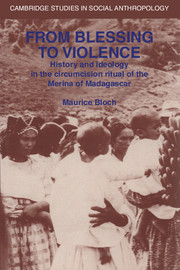Book contents
- Frontmatter
- Contents
- Preface
- 1 The social determination of ritual
- 2 Background politico-religious history of the Merina, 1770–1970
- 3 Background to Merina social organisation and religion
- 4 Description and preliminary analysis of a circumcision ritual
- 5 The symbolism of circumcision
- 6 The myth of the origin of circumcision
- 7 The history of the circumcision
- 8 The circumcision ritual in history: towards a theory of the transformation of ideology
- Notes
- References
- Index
- CAMBRIDGE STUDIES IN SOCIAL ANTHROPOLOGY
2 - Background politico-religious history of the Merina, 1770–1970
Published online by Cambridge University Press: 05 June 2012
- Frontmatter
- Contents
- Preface
- 1 The social determination of ritual
- 2 Background politico-religious history of the Merina, 1770–1970
- 3 Background to Merina social organisation and religion
- 4 Description and preliminary analysis of a circumcision ritual
- 5 The symbolism of circumcision
- 6 The myth of the origin of circumcision
- 7 The history of the circumcision
- 8 The circumcision ritual in history: towards a theory of the transformation of ideology
- Notes
- References
- Index
- CAMBRIDGE STUDIES IN SOCIAL ANTHROPOLOGY
Summary
To trace the development of ideology in central Madagascar during the nineteenth and twentieth centuries a specific case has been chosen, that of the circumcision ritual, because it is only in the light of a really clear and detailed case that vague discussions on ideology can be genuinely put to the test. This narrow focus, however, is the source of a difficulty. It would be totally misleading to imagine that by looking closely at this one ritual, however important it may be, it is possible to understand the nature and processes of Merina history. It is first necessary to outline the general background in order to show the significance of the ritual and its transformation. This chapter sets out to do this and briefly covers the history of central Madagascar, paying particular attention to religion. Similarly, the next chapter provides the background for social organisation and symbolism. Neither chapter represents genuinely original work, but the approach is different from that of most other writers on these topics in relation to Madagascar.
Madagascar has always been considered an anthropological oddity, due to the fact that although geographically it is close to Africa the language spoken throughout the island clearly belongs to the Austronesian group spoken in Southeast Asia; more particularly Malagasy is linked to the languages spoken in western Indonesia. These surprising facts are also reflected in the biological and cultural affinity of the people.
- Type
- Chapter
- Information
- From Blessing to ViolenceHistory and Ideology in the Circumcision Ritual of the Merina, pp. 12 - 33Publisher: Cambridge University PressPrint publication year: 1986

